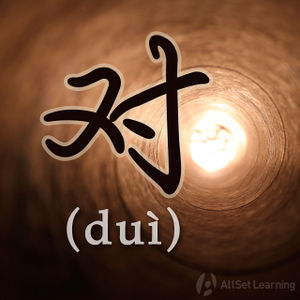Comparing "gen" and "dui"
-
Level
-
Similar to
-
Used for
-
Keywords
\r\n
跟 (gēn) and 对 (duì) sometimes seem like they mean the same thing, and at other times they seem to be different.After reading this article, you will know the difference! \r\n == When they have the same form and same meaning when used with 说 ==\r\nWhen using the verb 说, 跟 and 对 can both be used in a similar sentence pattern. 跟 and 对 are both prepositions, and they both express one person speaking to another. \r\n
=== Structure ===\r\n
Person A + 跟/对 + Person B 说
\r\n==== Examples ====\r\n
- 我 跟 她 说 了,但是 她 不 信。I told her, but she didn't believe me.
- 我 对 她 说 了,但是 她 不 信。I told her, but she didn't believe me.
- 他 对 我 说 他 爱 我。He told me he loved me.
- 他 跟 我 说 他 爱 我。He told me he loved me.
- 刚才 你 对 他 说 什么 了?What did you just tell him?
- 刚才 你 跟 他 说 什么 了?What did you just tell him?
\r\n== When they have a similar grammar structure but different meanings ==\r\n跟 and 对 can be verbs, and they often are used with a 着, however their meanings are different. \r\n === Structure ===\r\n
Subject + 跟/对 + Object
\r\n==== Examples for 跟====\r\n跟 is a verb, and it's simplest meaning is "follow." Often it is used as a verb phrase, such as 跟着, 跟上, 跟不上, 跟得上, 跟somebody + Verb.\r\n\r\n
- 这 只 小 猫 总是 跟着 我。This little cat always follows me.
- 你 走 得 太 快 ,我 跟不上。You walk too fast, I can't keep up.
- 你 想 跟 我 去 吗?Do you want to go with me?
\r\n==== Examples for 对====\r\n对 is also a verb, put it has the meaning of "towards" or "point to." Often it is used as: 对着, 对上, 对不上.\r\n
- 枪口 不 要 对着 人。Don't point that at people.
- 我 喜欢 对着 镜子 笑。I like to laugh at myself in the mirror.
- 这 两 本 账 对不上。These two accounts don't match up.
\r\n== When to use 跟 and not 对 ==\r\n跟 is a proposition, and it can be used in comparison. It will often have a supplementary explanation, similar to how 和 can be used (as in 我和你一样高). 对 cannot be used this way.\r\n === Structure 1 ===\r\nThis structure is used to explain that two things are (or aren't) similar.\r\n
A + 跟 + B + (不)一样
\r\n==== Examples ====\r\n
- 我 跟 你们 不一样,我 还 有 孩子 呢。I am not like you guys. I still have kids.
- 上海 跟 纽约 一样,都 是 国际 大 都市。Shanghai and New York are alike; they are both international cities.
\r\n=== Structure 2===\r\nThis structure shows that two nouns are the same in some some aspect, which is the word that follows "一样".\r\n
A + 跟 + B + (不)一样 + Adjective
\r\n==== Examples ====\r\n
- 我 现在 跟 我 爸 一样 高。Now I'm as tall as my dad.
- 你 跟 你 妈 一样 喜欢 买 衣服。You like to buy clothes just like your mother.
\r\n=== Structure 3 ===\r\n"跟" functions as a conjunction in this structure, joining two things together. Generally, these are nouns or pronouns (as with "和"). "对" cannot function like this.\r\n
Subject 1 跟 Subject 2 + VO
\r\n==== Examples ====\r\n
- 你 要 跟 我 一起 去 吗?Are you going to go with me?
- 鲜花 跟巧克力 是 最 好 的 礼物。Flowers and chocolate are the best gifts.
\r\n== Examples when to use 对 and not 跟 ==\r\n=== Structure ===\r\nWhen 对 as a proposition, it points to a certain target,since it can mean "point to" or "toward to". 跟 can only be used this way with 说.\r\n
Subject 1 对 Subject 2 + Verb
\r\n==== Examples ====\r\n
- 那 个 美女 正 对 我 笑 呢。That pretty girl is laughing at me.
- 不 要 对 老板 发脾气, 不然 后果 很 严重。Don't lose your temper with the boss, otherwise there will be serious consequences.
\r\n== Example Dialog ==\r\n
- A: 那 个 帅哥 在 对 我 招手!That handsome guy is motioning for me to go to him!
- B: 那 你 要 跟 他 去 吗?Well, are you going to go with him?
\r\n== See also ==\r\n* Expressing "with" with "gen"
- Using "dui"\r\n== Sources and further reading ==\r\n=== Books ===\r\n*现代汉语八百词(增订本) (跟 p. 201) →buy\r\n=== Dictionaries ===
- 现代汉语词典(第5版) (跟p.465 对p.343) →buy\r\n



